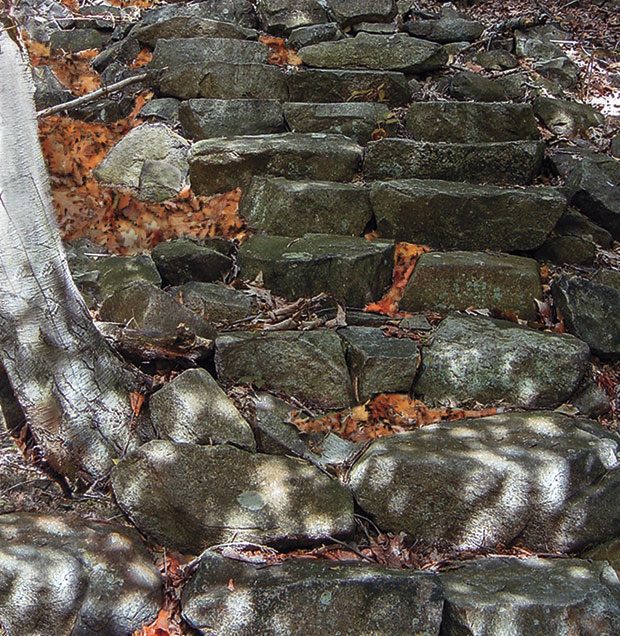
In the doldrums of late August 2005, with freshman year of high school looming, my friends and I set out on one last summer adventure: to search for the mysterious 300 Stone Steps. Growing up in Morris Plains, one could not help hearing tales of the steps, which were said to ascend Watnong Mountain. Below its 965-foot peak there is forest, hiking trails, a children’s park, a paved road and the housing development where I grew up. Did the steps really exist?
Tucking the cuffs of our jeans into our socks to ward off ticks, we packed a portable radio and some granola, and walked up the road, called Mountain Way, to one of the hiking trails. In the dense summer heat, we made our way up the trail, looking on both sides for signs of the steps. The mountain did not give up its secret. We returned on a second day. Still, no luck.
On the third day, we had hiked up the trail less than 100 yards from Mountain Way when one of my friends, wandering off to the right, cried out, “Wait! Look at this!” Camouflaged under dirt and leaves, she had found the steps. Exhilarated, we hurried over and began to climb.
The flat granite rocks snaked up the hillside. Many of the stones were wobbly. We steadied ourselves by grabbing onto birch saplings growing alongside the trail. Some of the saplings proved too whippy to be helpful. Others snapped as we lunged for them. Vintage beer cans were scattered in the surrounding woods.
The climb took only about 30 minutes. The steps ended well below the peak. Nearby we could see a water tower, and giant high-tension lines cut a wide swath across the hill. Near where the woods met the cleared area for the power lines we spotted a junked car.
While we had conquered the steps, we had not unravelled the mystery of their origin. People in Morris Plains have long debated who built the steps and why. Some say they date back to the area’s original residents, the Lenni-Lenape. Others credit George Washington’s soldiers. (The summit served as the location of Beacon 13, a strategic lookout where bonfires were used to signal Washington’s staff about British troop movements.) Another theory says patients from nearby Greystone Psychiatric Hospital built the steps as part of a work-based therapy program.
People in Morris Plains have been looking for the steps probably for as long as they have been arguing about who built them. “I would search for the stones with a friend, getting lost occasionally,” says Virginia Dyer Vogt, a Morris County historian who became a novelist after a career in advertising. Vogt used the steps in a key scene in her 2003 murder mystery, The Stone Steps. Her research left her convinced that the steps were built to provide access to Beacon 13.
But in 2008, Morris Plains history buff Peter Owens stumbled upon the ultimate clue. Sifting through Greystone’s archives, Owens found a frayed construction report indicating that the steps were built in the 1870s by miners to provide access to Malley’s Quarry on the mountain. Granite from the quarry was used to build Greystone Hospital one mile away.
Owens’s discovery is not widely known in Morris Plains, so people’s imaginations still roam. But with Greystone Psychiatric Hospital’s historic Kirkbride Building due to be demolished by year’s end, perhaps we should start thinking of the stone stairway as a monument to those who lived and worked at Greystone.
History is muddled. Files are tossed. People come and go. But the 300 Stone Steps remain, an indestructible, if elusive, link to our past.

What took you?